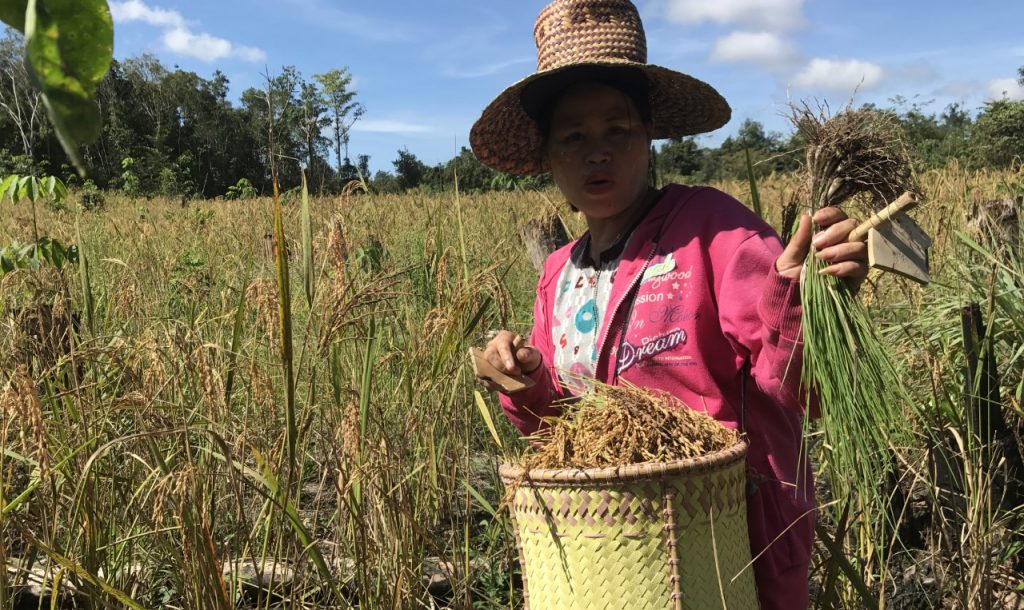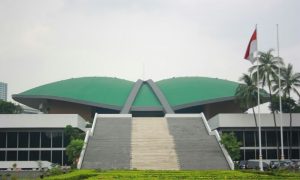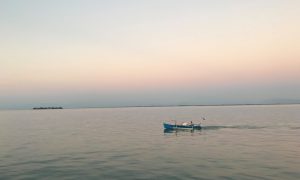A year has passed since the Indonesian government declared the outbreak of COVID-19 in the country. Infections have surpassed more than 1.5 million cases, claiming more than 43,000 lives. The Indonesian government has imposed large scale social distancing or PSBB (Pembatasan Sosial Berskala Besar) since April 2020, creating a dilemma for the household economy. For many urban poor and informal workers in the city, staying at home means losing their livelihood. Yet working means exposure to the virus.
The 2019 Centre of Statistics Bureau states that the number of those living in poverty in rural areas is higher than the number of poor in the cities (15.1 million in rural areas compared to 9.9 million in the urban areas). Despite this, following the virus outbreak, 7% of Indonesian people in the cities—the majority migrant, informal and seasonal workers—decided to return to their respective villages, finding ways to secure their survival despite the government’s ban on mudik or the annual return to hometowns before the Eid holiday.
It is worth examining the contradictions that arise from the fact that villages are simultaneously regions with higher incidences of poverty, yet have been treated as a safety net for city dwellers since the pandemic struck. Poverty is experienced unevenly in rural areas, with some managing to elude the poverty that is prevalent in the cities.
Poverty indicators are insufficient for capturing phenomena in which those who may not consume or possess a decent life by modern standards can actually maintain basic survival through means not possible amid urban life. Poverty data issued by the government cannot be the only reference for understanding the household economy during the pandemic. Such indicators are incapable of portraying the character of social reproduction in rural areas, specifically in places where indigenous communities live.
While the problem of food security has become central, many indigenous women in rural areas have shown their resilience in providing food for their families amid the pandemic. The key to this resilience is their role in social reproduction, which is embedded in daily life.
The concept of social reproduction engages the premise that the global economic system relies on the role of women in the reproduction of human life. While people of all genders increasingly join increasingly precarious labour forces, women continue to bear the brunt of roles managing shelter, providing food and other unpaid care work crucial to sustaining life. Workers’ participation in the global market economy remain dependent on the functioning of the so-called domestic sphere. Bhattacharya asserts there is an inseparable circuit of production and social reproduction sustaining capital accumulation at the global level.
In the context of the pandemic, it is worth taking a closer look at the sphere of social reproduction for explanations of who is able to endure the current conditions of precarity. For indigenous women in particular, access to or control over the means of production reduces their dependency on the market to fulfil their daily needs. Devi Anggraini, the Head of the Women’s Indigenous Peoples’ Alliance of the Archipelago (PEREMPUAN AMAN), estimates that 70% of farming activities in Indonesia are conducted by indigenous women, contributing to the food security of 31 million Indonesian people. They may rely on the market for specific commodities, but amid PSBB’s mobility constraints, many still have their own food resources and manage to feed themselves. This situation is different to the experiences of many urban poor women, who rely far more heavily on market mechanisms for their survival.
Here we would like to tell stories of real women with different backgrounds, living spaces, and economic situation, to show a spectrum of experiences during the pandemic. Maria, Mince and Anik, either as homemakers or heads of the family, have been subject to the government’s measures aimed at preventing the spread if COVID-19. However, each’s access to food has been affected differently.
Maria
Maria is an indigenous woman of Dayak Benuaq who lives with her husband and children in a rural area in West Kutai, East Kalimantan. Following the outbreak of the pandemic, many indigenous peoples in Indonesia left their villages and isolated themselves in their fields (ladang). This custom was a local initiative that helped to prevent the spread of the virus.
Maria and her family also isolated themselves in their field where they could fulfil their food and nutritional needs. Unfortunately, some of the area is enclosed by a palm plantation, which caused a neighbouring river to overflow and flood part of Maria’s field and that of other villagers.
Maria and her family did not receive any COVID-19 relief from the government. She believes that village governments prioritised their relatives as beneficiaries of social assistance. Fortunately, she joined a national indigenous women organisation that provided some food assistance. When she was asked what her needs were, she said she only needed 20 kilos of rice to last one month. She could get other foods such as vegetables and from the available farmland.
Mince
Mince is an indigenous woman of Rendu, East Nusa Tenggara. After her husband passed away in the early 1990s, Mince and her two children decided to return to her mother’s village. In Rendu, Mince received a plot of farmland from the indigenous leaders in the community as part of a decision to distribute housing lots and farms for newly married couples and widows.
Since 2016, her village has been among the areas affected by the construction of the Lambo Reservoir. Part of the Rendu territory will be drowned by the water catchment, including Mince’s field and house. Mince and other indigenous women in the area protested against the reservoir plan and have temporarily halted its implementation. But during their protests, Mince and other indigenous women in the area suffered verbal and physical violence from the police.
Typically, Mince only goes to the market once a month. It is about a two-hour journey from the village to the market and, like many others, she cannot drive a vehicle. Meanwhile, taking an ojek (motor ride) is expensive. Sometimes Mince hitches a ride on a pick-up car owned by her neighbours to the market. She usually only buys salt and cooking oil. When the local government advised people not to leave their villages, Mince mainly worried about how to get salt. She could obtain other foods such as rice, vegetables, eggs and fish from the rice fields, forest and farm.
Anik
Anik is a widow from Pekanbaru City, Riau. She does not have a fixed income and meets her daily needs by relying on assistance from her daughter and son in-law. Since the enactment of PSBB, her son-in-law has been unable to work, so she relies on her daughter who is still working in the retail industry. Since PSBB, her daily meals have consisted only of rice with chilli and salt.
Her neighbour, Yus, a widow with six children, is facing the same conditions. She used to be a food vendor in front of a school, but since schools are temporarily closed, Yus is no longer able to work. Instant noodles have become a daily meal for her and her children since PSBB. Anik contacted the head of her urban village to ask about government assistance but did not receive a response.
Shared insecurity in the cities and villages
As the stories above showed, the ability of women to survive during the pandemic is related to ownership and access to food resources. Ownership and cultivation of food resources, in many societies, is embedded in women’s roles in social reproduction and their unpaid roles in family care and housework. The experiences of Anik and her neighbour, Yus, are shaped by their surrounding, privatised environment in the cities, which no longer provides collective living spaces to sustain people’s basic needs.
While some indigenous communities have been less affected by the pandemic, social reproduction is instead a site of struggle amid an ongoing threat that they will be displaced from the communal or customary land that make up their livelihood sources. 40% of indigenous villages are located both within and around forest zones. Indigenous women farmers occupy the marginal circuit of capitalism as they are not incorporated into the wage labour system, yet live in constant tension with capital accumulation of global supply chains.
Maria and Minke are active political agents who battle aggressive large-scale industrialisation that endangers their sources of livelihood. Poor women, particularly indigenous women, have been negatively impacted by the crisis of land encroachment and displacement. In 2019, at least six indigenous tribes (among others, the tribes of Maybrat, Iwaro, Yeinan, Marind, Mandobo and Arfak) in Papua lost around 228,510 hectares of their forests due to the expansion of a palm plantation. Cases exist in Papua and Kalimantan where dispossessed indigenous women have been left to work as cheap plantation labourers in what they knew as their ancestor’s land.
The migration of working class city dwellers back to their villages, against the government’s advice not to go out of town, signifies a concrete material problem of survival in both the cities and rural areas. The cities are treated as a main site for employment opportunities yet it fails to provide basic food security when the market is disrupted. Concurrently, many rural areas and indigenous villages are facing threats of land transformation and dispossession that push people to flock into the cities for jobs. Protecting rural indigenous people’s access to and control over the means of production is also linked to the wellbeing of migrant workers in the cities.
This contradiction is likely to worsen under the recent passing of the Omnibus Law, which will provide a legal basis for land dispossession by extractive industries in indigenous communities where women play a central role. Meanwhile, the draft of the Indigenous Communities Law, which would enable recovery schemes to compensate the impact of the agrarian and ecological crises, has been postponed by the national parliament for the last 13 years.
The pandemic has rendered Indonesia prone to a food crisis, but any solution needs to address the problems of ongoing agrarian conflict and land transformation. Our policies in suppressing the spread of COVID-19 will determine whether we will fall into starvation. President Joko Widodo’s economic plan for 2015-19 has placed a strong emphasis on a growth rate of 7%. Yet COVID-19 has yet to be taken as a hard lesson in sustainable development. The emphasis on ecologically destructive industries and the continuation of mega infrastructure projects for boosting investment are development with no vision of sustainability.
At the face of multiple crises, women like Minke and Maria could represent our last bastion of food survival. However, the free and collective food supplies within their living space are under constant threat. If we continue to approve and continue an economic system that sets itself on profit or growth rates over people’s welfare, then we are not securing the Indonesian economic system from the pandemic or any other crisis that could emerge in the future.
 Facebook
Facebook  Twitter
Twitter  Soundcloud
Soundcloud  Youtube
Youtube  Rss
Rss 


